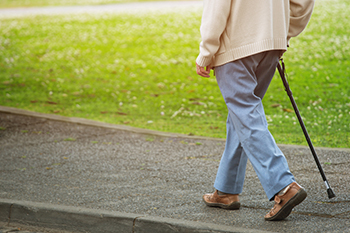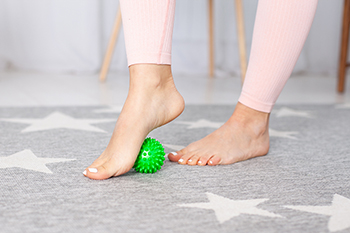
Wilmington (937) 382-2347
Fax
(513) 932-1606

Wilmington (937) 382-2347
Fax
(513) 932-1606
 As the feet age and get older, they take a beating while supporting the body’s weight. As the skin gets older, it begins to lose elasticity as well which can lead to more blisters, cuts, and infections. Thankfully, there are a few things that the elderly can do to help care for their feet and prevent future issues. First off, it is important to keep the feet clean and dry. This will help reduce the chances of fungi forming and causing issues such as athlete’s foot or fungal nail infections. In order to prevent ingrown toenails, it is key to keep the toenails trimmed short and straight across. Maintaining a healthy weight is also key to keeping pressure off of the feet. Any sores or wounds should be monitored and checked by a podiatrist as well. If you are experiencing pain in the feet, or if you have questions about caring for your feet, consulting with a podiatrist is key to keeping your feet healthy for a long time.
As the feet age and get older, they take a beating while supporting the body’s weight. As the skin gets older, it begins to lose elasticity as well which can lead to more blisters, cuts, and infections. Thankfully, there are a few things that the elderly can do to help care for their feet and prevent future issues. First off, it is important to keep the feet clean and dry. This will help reduce the chances of fungi forming and causing issues such as athlete’s foot or fungal nail infections. In order to prevent ingrown toenails, it is key to keep the toenails trimmed short and straight across. Maintaining a healthy weight is also key to keeping pressure off of the feet. Any sores or wounds should be monitored and checked by a podiatrist as well. If you are experiencing pain in the feet, or if you have questions about caring for your feet, consulting with a podiatrist is key to keeping your feet healthy for a long time.
Proper foot care is something many older adults forget to consider. If you have any concerns about your feet and ankles, contact Dr. Gerald Perelman from Ohio. Our doctor can provide the care you need to keep you pain-free and on your feet.
The Elderly and Their Feet
As we age we start to notice many changes in our body, but the elder population may not notice them right away. Medical conditions may prevent the elderly to take notice of their foot health right away. Poor vision is a lead contributor to not taking action for the elderly.
Common Conditions
Susceptible Infections
Diabetes and poor circulation can cause general loss of sensitivity over the years, turning a simple cut into a serious issue.
If you have any questions please feel free to contact our office located in Wilmington, OH . We offer the newest diagnostic and treatment technologies for all your foot and ankle needs.
 The plantar fascia is a ligament that runs along the bottom of each foot, connecting the heel bone to the toes. When this ligament is injured or inflamed, the result is usually heel and arch pain. One way to prevent or relieve tension and pain in the heel, arch, and sole of the foot is by stretching. To stretch the plantar fascia and relieve tightness under the foot, you can do a foot pull. Sit with one leg crossed over the other, then grab all of your toes and pull them as a unit back towards your shin, until you feel a pull in the bottom of your foot. Hold for 10 seconds and repeat 10 times. To massage the plantar fascia, roll a tennis ball forward and back with the bottom of your foot for 5-10 minutes a day. To learn more about plantar fascia stretches, please consult with a podiatrist.
The plantar fascia is a ligament that runs along the bottom of each foot, connecting the heel bone to the toes. When this ligament is injured or inflamed, the result is usually heel and arch pain. One way to prevent or relieve tension and pain in the heel, arch, and sole of the foot is by stretching. To stretch the plantar fascia and relieve tightness under the foot, you can do a foot pull. Sit with one leg crossed over the other, then grab all of your toes and pull them as a unit back towards your shin, until you feel a pull in the bottom of your foot. Hold for 10 seconds and repeat 10 times. To massage the plantar fascia, roll a tennis ball forward and back with the bottom of your foot for 5-10 minutes a day. To learn more about plantar fascia stretches, please consult with a podiatrist.
Stretching the feet is a great way to prevent injuries. If you have any concerns with your feet consult with Dr. Gerald Perelman from Ohio. Our doctor will assess your condition and provide you with quality foot and ankle treatment.
Stretching the Feet
Stretching the muscles in the foot is an important part in any physical activity. Feet that are tight can lead to less flexibility and make you more prone to injury. One of the most common forms of foot pain, plantar fasciitis, can be stretched out to help ease the pain. Stretching can not only ease pain from plantar fasciitis but also prevent it as well. However, it is important to see a podiatrist first if stretching is right for you. Podiatrists can also recommend other ways to stretch your feet. Once you know whether stretching is right for you, here are some excellent stretches you can do.
It is best to go easy when first stretching your foot and work your way up. If your foot starts hurting, stop exercising and ice and rest the foot. It is advised to then see a podiatrist for help.
If you have any questions, please feel free to contact our office located in Wilmington, OH . We offer the newest diagnostic and treatment technologies for all your foot care needs.
There are three common toe deformities that podiatrists often see and treat in patients. Hammertoes are characterized by the downward bending of the toe at the proximal interphalangeal (PIP) joint, located in the middle of the toe. Mallet toes are characterized by the downward bending of the toe at the distal interphalangeal (DIP) joint, located near the tip of the toe. Claw toes are characterized by an upwards bend of the toe at the metatarsophalangeal (MTP) joint, located at the base of the toe. All three of these deformities can cause pain and stiffness. Corns and calluses are more likely to develop on affected toes as they rub up against the shoes while you walk. If you have a painful toe deformity it is suggested that you seek the care of a podiatrist.
Hammertoes can be a painful condition to live with. For more information, contact Dr. Gerald Perelman of Ohio. Our doctor will answer any of your foot- and ankle-related questions.
Hammertoe
Hammertoe is a foot deformity that occurs due to an imbalance in the muscles, tendons, or ligaments that normally hold the toe straight. It can be caused by the type of shoes you wear, your foot structure, trauma, and certain disease processes.
Symptoms
Risk Factors
Treatment
If you have hammertoe, you should change into a more comfortable shoe that provides enough room for your toes. Exercises such as picking up marbles may strengthen and stretch your toe muscles. Nevertheless, it is important to seek assistance from a podiatrist in order to determine the severity of your hammertoe and see which treatment option will work best for you.
If you have any questions, please feel free to contact our office located in Wilmington, OH . We offer the newest diagnostic and treatment technologies for all your foot care needs.
Blisters on the feet are typically the result of friction from shoes or socks rubbing against a concentrated area of skin as you go about your day. Though they can be annoying and uncomfortable, these types of blisters are usually not a cause for concern and tend to go away on their own. If you find yourself with a friction foot blister, do your best to leave it alone. Don’t poke, prod, or pop it. Keep the area clean and cover it with a padded bandage or wrap to protect it from further friction. If the blister pops on its own, wash the area with water and a gentle soap, smooth down the remaining skin flap, apply an antibiotic ointment, and cover with a bandage. If your blister is showing signs of infection, such as redness or oozing, please seek the care of a podiatrist.
Blisters may appear as a single bubble or in a cluster. They can cause a lot of pain and may be filled with pus, blood, or watery serum. If your feet are hurting, contact Dr. Gerald Perelman of Ohio. Our doctor can provide the care you need to keep you pain-free and on your feet.
Foot Blisters
Foot blisters are often the result of friction. This happens due to the constant rubbing from shoes, which can lead to pain.
What Are Foot Blisters?
A foot blister is a small fluid-filled pocket that forms on the upper-most layer of the skin. Blisters are filled with clear fluid and can lead to blood drainage or pus if the area becomes infected.
Symptoms
(Blister symptoms may vary depending on what is causing them)
Prevention & Treatment
In order to prevent blisters, you should be sure to wear comfortable shoes with socks that cushion your feet and absorb sweat. Breaking a blister open may increase your chances of developing an infection. However, if your blister breaks, you should wash the area with soap and water immediately and then apply a bandage to the affected area. If your blisters cause severe pain it is important that you call your podiatrist right away.
If you have any questions, please feel free to contact our office located in Wilmington, OH . We offer the newest diagnostic and treatment technologies for all your foot care needs.